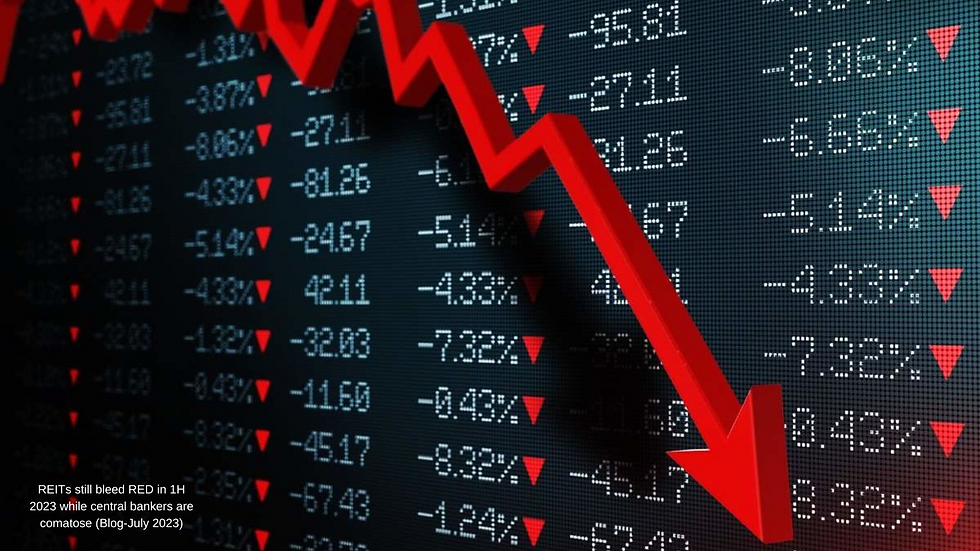FACT OR FALLACY? INTEREST RATE HIKES ARE AUTOMATICALLY BAD FOR SREITS?
- by Gabriel Yap

- Aug 24, 2018
- 3 min read
Updated: Sep 28, 2018
08/2018
SREITS have gone on the longest correction in the current decade – it has been down since 26 Jan 2018 and as at 22nd Aug 2018, it is 154 days into its correction compared to the mean of 99 days registered in the past 5 corrections of the current decade.

This current correction is largely triggered by the rise of the Singapore 10-year bond yield which has increased from barely 2% at the beginning of the year to 2.45% currently. Furthermore, a strengthening US$ is likely to continue to pressure the SIBOR and the Swap Offer Rate, SOR, higher which most market pundits are expecting to reach 2.8 – 3% range by the end of the year.
Admittedly, the interest rate hike-cycle has started to translate into a higher cost of debt for REITS, but one must be cognizant that the relatively higher cost of funds that SREITS now face, are indeed very modest compared to the number of times that the Federal Reserve has raised its interest rates. So far, the Fed has raised interest rates twice by a total of 50 bp and have signaled another 2 more rate rises this year and 3 for 2019.

An analysis into SREITS latest quarterly results as at Jun 2018 have shown that the interest rate impact is only 0 – 20 bp since Dec 2017. For instance, the sharpest rise in cost of debt among Retail Reits was MCT which saw its cost of debt increased 18 bp in the past 6 months.

For Industrial REITS, the trio of MLT, ESR Reit and AIMPS AMPI Reit saw their cost of debt increased 20 bp in the past 6 months, the highest among Industrial REITS. This was despite the former going on an expansion acquisition acquiring 11 China assets worth RMB1,021 Billion.
And for Commercial REITS, CCT registered a 20 bp increase in its cost of debt increased 20 bp in the past 6 months, the highest among Commercial REITS.

A few well-positioned REITS, namely, Capitaland Mall Trust, SPH Reit, Ascendas Reit, Frasers Logistics Trust, Parkway Life Reit, Keppel DC Reit, Ascott Reit and Mapletree NAC actually have not seen the current round of interest rates hikes hitting their cost of funds yet. For the smart investor, details like this matter as they help you to decide which REITS to hold and which REITS to avoid as interest rates rise.
Thus, prognosticators that have predicted a similar scenario like the crash of 2008 – 2009 have missed the forest for the trees. Then, interest rates rose sharply while capital values fell and REITS scrambled to fortify their balance sheets, some to the extend to issuing deeply-discounted rights at a time when most minority shareholders are short of funds.

Another big difference is that during the GFC of 2008, SREITS were at real high gearing ratios of 40% and many have issued commercial mortgaged-backed securities, which would rock the SREITS balance sheets. Moreover, most bank loans were due within 3 years.
1 decade later, current gearing for SREITS are between 34 – 36% and most SREITS have diversified away from plain vanilla bank loans or bonds into a mix of perpectual securities, long-tenor loans of 5 – 7 years, retail bonds and convertible bonds.
For a detailed assessment of which SREITS have protected themselves well against the current interest rate hike-cycle and which are vulnerable, do join us in our upcoming Quarterly REITS Class – Is Spring Dawning for SREITS on 1 Sep 2018.
Do SIGN UP HERE at https://gcpglobalsg.wixsite.com/gcpglobal/events-1/is-spring-dawning-for-sreits
Participants who sign up for the 1 Sep 2018 will also be invited to see aspiring EC World Reit assets in Hangzhou in October 2018, indeed a Learn-and-See experience, a key ingredient in all GCP Global’s teachings.




Comments